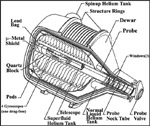WEEKLY UPDATE FOR 22 APRIL 2005:
GRAVITY PROBE B MISSION STATUS AT A GLANCE

| Item | Current Status |
| Mission Elapsed Time | 367 days (52 weeks/12.00 months) |
| Science Data Collection | 238 days (34 weeks/7.80 months) |
| Current Orbit # | 5,419 as of 9:00 PM PST |
| Spacecraft General Health | Good |
| Roll Rate | Normal at 0.7742 rpm (77.5 seconds per revolution) |
| Gyro Suspension System (GSS) | All 4 gyros digitally suspended in science mode |
| Dewar Temperature | 1.82 kelvin, holding steady |
| Global Positioning System (GPS) lock | Greater than 88.0% |
| Attitude & Translation Control (ATC) | X-axis attitude error: 163.0 marcs rms |
| Command & Data Handling (CDH) | B-side (backup) computer in control Multi-bit errors (MBE): 0 Single-bit errors (SBE): 9 (daily average) |
| Telescope Readout (TRE) | Nominal |
| SQUID Readouts (SRE) | Nominal |
| Gyro #1 rotor potential | -4.3 mV |
| Gyro #2 rotor potential | -5.5 mV |
| Gyro #4 rotor potential | -5.7 mV |
| Gyro #3 Drag-free Status | Backup Drag-free mode (normal) |
MISSION DIRECTOR'S SUMMARY
As of Mission Day 367, the Gravity Probe B vehicle and payload are in good health. All four gyros are digitally suspended in science mode. The spacecraft is flying drag-free around Gyro #3.
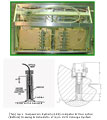
Our mission operations team performed routine tasks over this past week related to the electrostatic discharge of Gyro #3 (the “drag-free” gryo) and minor Dewar pressure oscillations. After performing a number of tests on Gyro #3 early in the week, it was discharged on Thursday to -3.0 mV, using ultraviolet light, as explained in last week's update.
The Attitude and Translation Control (ATC) group reports that the time required to re-lock onto the guide star as the spacecraft emerges from behind the Earth each orbit continues to be excellent, including one guide-star capture (re-locking) this weekend that took only 20 seconds.
On Tuesday afternoon (19-Apr), GP-B Principal Investigator, Francis Everitt, delivered a Physics Colloquium to a packed auditorium at Stanford entitled: “The Gravity Probe B Flight Mission: A Stanford Physics-Engineering Partnership”. In this lecture, Professor Everitt explained some of the finer points of GP-B's various technologies, emphasizing in each case the interdisciplinary collaborations required to produce these extraordinary technological innovations.
MISSION NEWS—GRAVITY PROBE B CELEBRATES LAUNCH ANNIVERSARY
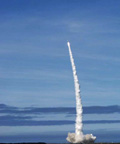
 This past Wednesday, 20 April 2005, marks the one-year anniversary of the GP-B spacecraft in orbit. At 9:57:24 am PDT on 20 April 2004, a Boeing Delta II rocket carried the GP-B spacecraft, embodying over 40 years of dogged persistence in science and engineering, into a perfect orbit. That emotionally overwhelming day, culminating with the extraordinary live video of the spacecraft separating from the second stage booster meant, as GP-B Program Manager Gaylord Green put it, "that 10,000 things went right."
This past Wednesday, 20 April 2005, marks the one-year anniversary of the GP-B spacecraft in orbit. At 9:57:24 am PDT on 20 April 2004, a Boeing Delta II rocket carried the GP-B spacecraft, embodying over 40 years of dogged persistence in science and engineering, into a perfect orbit. That emotionally overwhelming day, culminating with the extraordinary live video of the spacecraft separating from the second stage booster meant, as GP-B Program Manager Gaylord Green put it, "that 10,000 things went right."
This past Wednesday, exactly one year later, the entire GP-B team gathered in the conference room where we hold our daily briefings for a launch anniversary celebration. We watched a 12-minute condensed video of the launch and reminisced for a few minutes about that historic event. Then, GP-B Principal Investigator, Francis Everitt, walked to the front of the room and made a poignant toast to the entire GP-B team.

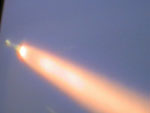
 Click here to view a 7-minute QuickTime video clip of the GP-B launch and spacecraft separation.
Click here to view a 7-minute QuickTime video clip of the GP-B launch and spacecraft separation.
Please note that the video requires the Apple QuickTime media player.Click here to link to download the QuickTime player for Mac or Windows. ![]()
Our first year in orbit has been quite an exciting ride. The 4-month Initialization and Orbit Checkout (IOC) period demonstrated the exceptional preparedness and dedication of our team, from dealing with computer reboots and thruster problems in orbit to spinning up the four gyros, which following the launch, was the second greatest milestone in the program.


On 28 August 2004, we began the 10+ month science phase of the mission, collecting data on the changing spin axis orientation of the four gyros that will ultimately confirm or disprove the geodetic and frame-dragging predictions that arise from Albert Einstein's general theory of relativity--the theory of gravity that he published in 1916, 11 years after publishing his special theory of relativity. It is fitting that the completion of the Gravity Probe B experiment, perhaps the most rigorous test to date of general relativity, will come to fruition this year--the 100th anniversary of Einstein's “miracle” year, in which he published four seminal papers, including the special theory of relativity and his paper on the production and transformation of light, for which he was awarded the Nobel Prize in 1921.


The GP-B spacecraft is now performing better than ever, but there have been some challenges during the science phase of the mission. For example, on January 17th, an X-class solar flare--the largest in thirteen years--caused the science telescope to be temporarily blinded by an associated high flux of energetic protons. When such an event occurs, the hum of pagers and a cacophony of cell phone ringers can be heard, alerting the team. In this case and other anomalous situations, including the automatic switchover from the A-side (main) flight computer to the B-side (backup) computer two months ago, our mission operations team has always been able to restore normal flight operations within a few hours, with minimal loss of science data. In fact, we have now collected nearly 8 months of science data, with a 99% success rate.
We are now in the process of measuring the amount of liquid helium remaining in the spacecraft's Dewar. Shortly before the helium runs out sometime late this summer, we plan to perform a series of critical instrument calibrations. The purpose of these calibrations is to place limits on potential sources of systematic errors. Most of these tests call for intentionally enhancing, in a controlled fashion, one or more possible error terms. By increasing a disturbance during the calibration phase, we are better able to place tighter limits on these errors.
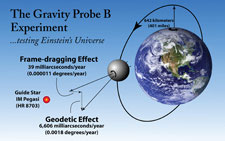
So was Einstein correct? We don't know yet. It is critically important to ensure data accuracy and analysis integrity, and thus, we will not be releasing any scientific results until after the data analysis is completed next summer.
UPDATED NASA/GP-B FACT SHEET AVAILABLE FOR DOWNLOADING
We recently updated our NASA Factsheet on the GP-B mission and experiment. You'll now find this 6-page document (Adobe Acrobat PDF format) listed as the last navigation link under "What is GP-B" in the upper left corner of this Web page. You can also click here to download a copy.
THE EINSTEIN EXHIBITION AT THE SKIRBALL CULTURAL CENTER IN LOS ANGELES
 If you're going to be in Los Angeles anytime before 30 May 2005, and if you’re interested in Einstein’s life and work, the Einstein Exhibition at the Skirball Cultural Center (just north of the Getty Museum on Interstate 405) is the most comprehensive presentation ever mounted on the life and theories of Albert Einstein (1879-1955). It explores his legacy not only as a scientific genius who re-configured our concepts of space and time, but also as a complex man engaged in the social and political issues of his era. It examines the phenomenon of his fame and his enduring status as a global icon whose likeness has become virtually synonymous with genius.
If you're going to be in Los Angeles anytime before 30 May 2005, and if you’re interested in Einstein’s life and work, the Einstein Exhibition at the Skirball Cultural Center (just north of the Getty Museum on Interstate 405) is the most comprehensive presentation ever mounted on the life and theories of Albert Einstein (1879-1955). It explores his legacy not only as a scientific genius who re-configured our concepts of space and time, but also as a complex man engaged in the social and political issues of his era. It examines the phenomenon of his fame and his enduring status as a global icon whose likeness has become virtually synonymous with genius.
In this exhibit, you can examine Einstein's report card, inspect his FBI file, and enjoy his family photographs, love letters, and diary entries. Exhibition highlights include scientific manuscripts and original correspondence—including original handwritten pages from the 1912 manuscripts of the special theory of relativity and his 1939 letter to President Roosevelt about nuclear power—and a wealth of other documents from the Albert Einstein Archives at the Hebrew University of Jerusalem.



In addition to these displays of Einstein memorabilia, the exhibit also features a number of interactive components that help provide an understanding of Einstein's revolutionary theories. Furthermore, several “explainers,” identified by their red aprons, are on hand to discuss various aspects of the exhibit and to explain and demonstrate difficult concepts, such as time dilation and warped spacetime. At the end of the exhibit, you’ll find one of GP-B’s gyro rotors on display.
The Einstein exhibition was jointly organized by the American Museum of Natural History (AMNH), the Hebrew University of Jerusalem, and the Skirball Cultural Center. It was designed by the AMNH under the supervision of Dr. Michael Shara, curator of the exhibit and chairman of the museum’s Astrophysics Department. It opened in November 2002 at the AMNH in New York and then traveled to Chicago and Boston, spending about 8 months in each location. It will remain at its final U.S. stop at the Skirball Center in Los Angeles through 29 May 2005, after which time it will move permanently to the Hebrew University in Jerusalem.
Information about the Einstein exhibition is available on the Skirball Center Web site. If you can’t make it to Los Angeles, you can visit the AMNH’s virtual Einstein exhibit on the Web.
Drawings and photos: The Photoshop composite of the GP-B spacecraft in orbit and the diagram of the GP-B experiment were created by GP-B Public Affairs Coordinator, Bob Kahn. The drawings of the gyro rotor UV discharge system and the photo of the Gyro Suspension System (SS) electronics, as well as the photo and diagram of the Dewar are from the GP-B Photo & Graphics Archive here at Stanford. The first launch photo, showing the Delta II rocket and payload lifting off of the launch pad was taken by a photographer from the Boeing Corporation. The second launch photo, showing the rocket in the air, at the end of its vapor trail, was taken by Jim Burns, a member of the Stanford GP-B launch team at Vandenberg AFB last year. The shot of the rocket's vapor trail high above the coastline was sent to us by John Dickson of SantaBarbara.com. The photos of the rocket engine glow and the two photos showing the spacecraft separating from the second stage rocket were extracted from NASA KSC's launch video. The photos of the GP-B Mission Operations Center (MOC) and Anomaly Room were taken by GP-B Public Affairs Coordinator, Bob Kahn. Finally, the photos from the Einstein Exhibit are courtesy of the Skirball Cultural Center. Click on the thumbnails to view these images at full size.
MORE LINKS ON RECENT TOPICS
- Track the satellite in the sky
- Photo, video & and news links
- Build a paper model of the GP-B Spacecraft
- Following the mission online
- Our mailing list - receive the weekly highlights via email
- The GP-B Launch Companion in Adobe Acrobat PDF format. Please note: this file is 1.6 MB, so it may take awhile to download if you have a slow Internet connection.
Previous Highlight
Index of Highlights

